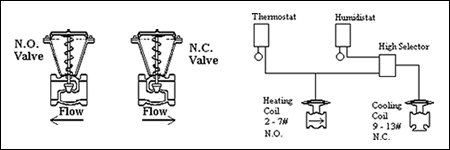 This seminar is designed for personnel who have a good background in HVAC systems and want to expand their knowledge into pneumatic controls systems. Individuals who attend this seminar can expect to gain a good understanding of the operation, calibration and troubleshooting of pneumatic HVAC control systems.
This seminar is designed for personnel who have a good background in HVAC systems and want to expand their knowledge into pneumatic controls systems. Individuals who attend this seminar can expect to gain a good understanding of the operation, calibration and troubleshooting of pneumatic HVAC control systems.
Monday
Basic control theory and terminology. Understanding the symbols and terminology of control systems. Basic HVAC processes are reviewed. Principles covered to include direct and reverse action, normally open and closed valves and dampers, spring range of actuators, etc. Devices covered will include theoretical and lab operations on thermostats, valves, damper operators, E.P., P.E., switching, reversing and selector relays. Basic pneumatic control systems, devices and their operational characteristics. Lab simulators will be used to allow students the "hands-on" side of control systems.
Tuesday
Receiver controls and master-submasters. Operational understanding and calibration procedures for single and dual input receiver control systems, sensors and temperature gauges. Use of receiver controller calibration kits on the lab simulators enhance the understanding of these systems. Receiver controllers by Honeywell, Johnson, Robertshaw and Barber-Coleman will be available to calibrate and troubleshoot. How to calculate and adjust proportional band, gain, authority (ratio) will be covered. Troubleshooting strategies and procedures.
Wednesday
"Systems Concept" of control systems. Treating controls, not as a single operational device, but as part of a larger operational system. The systems we will cover include Variable Air Volume (VAV), reheat, multizone, mixing box, 2 and 4 pipe fan coils, induction units, 100% O.A., unit-ventilator, etc. Typical control systems used on these types of systems with emphasis places on discharge controllers, mixed air controllers and economizer sequences.
Thursday
Systems troubleshooting and calibration. Selected systems will be simulated on the lab boards or, if available, actual "in operation" systems in accessible mechanical rooms will be used to provide "hands-on" calibration and troubleshooting. Severay system types will be used to give a good overview of the procedures to follow in a calibration and troubleshooting sequence. Also, "bugs" will be put into system to create a good environment for troubleshooting. Students will be able to put to use skills learned during the week.
Friday
Control drawings reading and interpretation. The ability to read and understand control systems drawings is essential to calibrate, troubleshoot, or operate a HVAC control system. Each student is provided with several sets of typical control prints from several different manufacturers. As a class, the drawings are read and discussed to give the students a good exercise in reading drawings. Actual drawings brought in by attendees may be used if suitable reproducing facilities are available. Electric and electronic control systems. Logical approaches to system troubleshooting. Motor starts and typical interfaces to pneumatic and electronic control hardware. Discussion of new technologies in control hardware to include analog electronic and Direct Digital Control systems.
NOTE: All participants will receive a textbook, various calibration and repair instructions on control devices and a completion certificate.